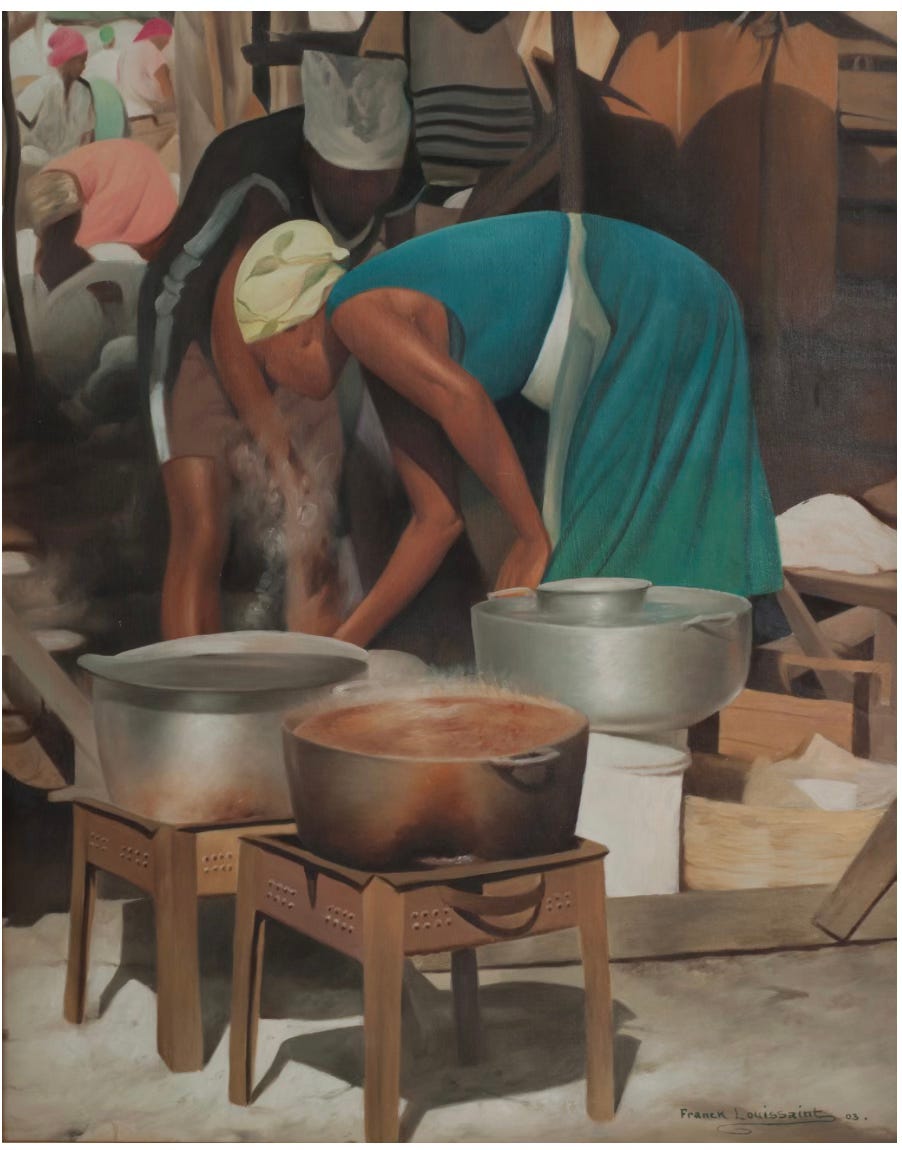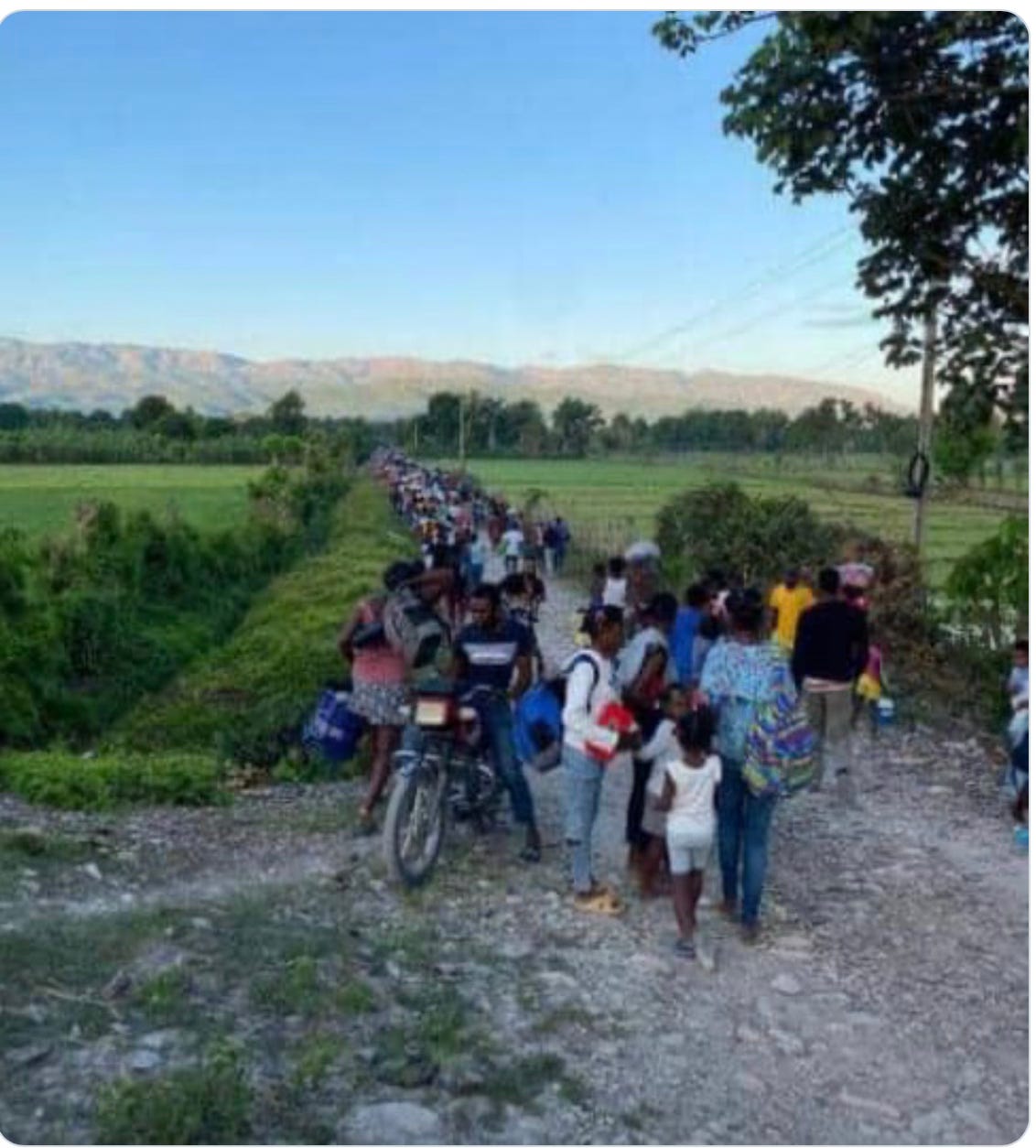Welcome to the latest edition of Woy Magazine’s biweekly newsletter, providing you with must-know news and commentary on Haiti and our Diaspora.
We can’t do this work without you. We have introduced a paid subscription option for our newsletter. Consider switching your free subscription to a paid one to support our work! Click the button below.
Yon sèl dwèt pa ka manje kalalou
One single finger cannot eat okra
(Haitian proverb)
CHAY LA | Main Story
What, to the Haitian worker, is May Day?
May 1st in Haiti is celebrated with much fanfare, particularly Fèt Agrikilti. This day is marked by fairs in town squares and schools throughout the country, highlighting locally grown food, art, and other local businesses. Jeremi, Okap, Petyonvil, Ench, and Jakmèl are only a few cities that hosted fairs this past week. Practioners of Vodou also honor the lwa of harvest and agriculture, Azaka Mede (Kouzen Zaka, Minis Azaka). Kouzen Zaka is the patron of all people who work the land and a defender of the poor. He is portrayed as wearing denim and a red handkerchief. Haitians honor Kouzen Zaka with offerings of crops.
Workers’ Day offers an opportunity to reflect and stand in solidarity with Haitian workers who have long been fighting for fairer working conditions. In our 2024 interview with Naomie St. Louis, coordinator of a trade union organization called ROHAM (Respect for Haitian Factory Workers), she explained the recent challenges to labor organizing in this current political and security crisis.
The insecurity has completely killed me as a union woman. In the factory where we work, we have a union. We try to recruit as many women as we can. Inside the union, we also have a women's organization. Whether or not a woman chooses to join the union, she has the right to join the women’s organization if she wishes. We would often go to other places for various trainings, and then we would return to share what we had learned with the other women inside the factory. After the closure of the factory, we kept fighting to work with the women, but in the end, we couldn’t.
Insecurity has affected me deeply and in so many facets of my life. But this specific facet, making it so that I can’t do my work as a union woman, this work that I love so very much, helping women, talking to women, making them understand their rights as workers — this has completely demoralized me, in every sense. I cannot find the words to explain how this insecurity has played out in the lives of women workers."Source: Hammer & Hope
Outside of the factories in the streets, the woman laborer is prominent. Sociologist Dr. Sabine Lamour, in a piece for Gazette Universitaire, analyzes the role of the machine manje. She argues these women are “agents who fashion the dynamics of daily life in the Haitian streets.”
En conclusion, les restauratrices de rue incarnent une infrastructure sociale vitale, articulant subsistance, soin et transmission culturelle. Le travail des restauratrices de rue est encastré dans des relations sociales. Le propre de ce travail de subsistance est de travailler avec et pour les autres(Collectif Rosa Bonheur, 2019) ; ainsi, la restauration de rue semble se confondre avec la vie elle-même. Ce travail de subsistance permet de mettre en relation des activités disparates et pourtant toutes orientées vers la survie économique, matérielle et morale des habitant.e.s précaires de la ville (Collectif Rosa Bonheur, 2019).
Elles sont au centre d’une dynamique où les femmes structurent une économie de survie. Il en résulte que la restauration de rue fait de la ville un espace créateur de lien social et de solidarités, tout en suggérant des « pratiques de création du monde » (Kern, 2020, p. 57). Sans le proclamer, la restauration de rue réitère le droit à la ville pour les gens issus du « pays en dehors » et pour les femmes. En tant qu’espace de leadership féminin, cette sphère socio-économique assure le double rôle de nourrir les précaires dans la ville et d’assurer le maintien des liens entre les personnes issues de cette catégorie. (Source: Gazette Universitaire)
POLITIK POLEMIK
The US designates Viv Ansanm & Gran Grif as terrorists.
The Viv Ansanm gang coalition and the Gran Grif gang were recently designated as foreign terrorist organizations by the U.S. Department of State amidst escalating violence in the country. The coalition, which we’ve discussed in previous newsletters, is led by Jimmy “Barbecue” Cherizier and comprises two main gang factions operating in Pòtoprens: G-9 and G-Pèp. Gran Grif is the largest gang in the Latibonit department and is reportedly responsible for 80% of the civilian deaths reported in the region.
For the gangs, this means no access to the U.S. financial system and the potential resources used to fund their operations, freezes on any property or interests located in the U.S. or under the control of a U.S. person, and prohibitions on any business coordinated with U.S. citizens.
However, this designation may have ramifications for unaffiliated actors on the ground, since individuals, including U.S. citizens, may face sanctions if they engage in specific interactions or conduct business with designated entities or individuals associated with Viv Ansanm or Gran Grif.
Concerns have been raised that this could worsen Haiti's ongoing hunger crisis, in a context where many, including aid organizations, are forced to negotiate with gangs who now control a minimum of 85% of the capital.
Business dealings are also expected to suffer, as gangs control critical infrastructure, including ports and roads. This is an important part of their strategy to generate income by monetizing their dominion over the territory through tolls and bribes.

Others view this designation as an important instrument that the CPT could use to dismantle the gang’s control over the territory. As the Presidential Transitional Council (CPT) and the international community continue to grapple with the challenge of addressing this crisis, the situation only seems to be escalating.

Ban on the Transit of Goods
To address the crisis at its root, a recent ban on the transit of goods through the Dominican Republic was set to take effect on April 7, 2025. Devised by the Haitian government to curb the flow of illegal weapons, this ban is also intended to stem an estimated $60-$75 million acquired through the extortion of shipping containers.
According to Alfred Metellus, the current Minister of Economy and Finance, the gangs can extort about $2,000 per container, enabling them to operate independently and fund their activities. This ban is, therefore, designed to limit their access to weapons, ammunition, and resources in the future.
Trade in border markets such as Dajabón should not be affected. According to Metellus, the ban only applies to goods from third-party countries and isn’t intended to penalize trade with the Dominican Republic.
Reparasyon - Restitisyon
Haitians are unimpressed with Emmanuel Macron’s recent announcement of a Franco-Haitian commission of historians to assess the impact of France's historic indemnity on Haiti and make recommendations. Professor Fritz Deshommes, Chair of the Haitian National Committee on Restitution and Reparation (CNHRR), characterized the announcement as a delay tactic that “allows for a wait-and-see approach. In reality, France shows no intention of addressing the issue of restitution in a direct and resolute manner.”
In a recent op-ed, Dr. Fania Noel argues that those in the know are well acquainted with the fact that commissions are where important matters die in French politics.
“When I want to bury a matter, I create a commission,” said Clemenceau. In 1963, General de Gaulle coined the term ‘Théodule committee’ as an ad hoc term for ineffective commissions created to bury problems or avoid solving them. Unsurprisingly, when French presidents want to deal with a matter of the utmost importance, they avoid creating any commissions or committees.
François Mitterrand, for example, declared: “I do not want to give France's atomic weapon to a European Théodule Committee that will not press the button unless the majority of its members are threatened.” And indeed, France has preserved its nuclear autonomy. (Source: AyiboPost)
The sum Haiti is owed might appear substantial; however, it only represents a mere .47% of France’s GDP in 2024, which was roughly $4.4 trillion. When examined strictly economically, this proportion underscores the relatively insignificant impact the repayment would have on France's overall economic landscape.
Imigrasyon
Marie Ange Blaise, a Haitian woman who was stopped while trying to board a flight in Saint Croix for Charlotte, North Carolina, died in ICE custody last week. Her death is currently under investigation, however she was detained by Immigration and Customs Enforcement (ICE) since February 12th for entering the U.S. without parole or a valid immigrant visa, and was since transferred to several facilities including a facility in San Juan, Puerto Rico, then to New Orleans, Louisiana, and later to a facility in Oakdale, Louisiana.
ICE maintains that detainees are never denied care and are provided with medical, dental, and mental health screenings as well as 24-hour emergency care. Judging by how Haitian migrants have been treated in the past and the recent attacks led by the Trump administration on immigrants, this is highly concerning. Being undocumented should not expose migrants to inhumane or unjust treatment, nor should it be a death sentence.




